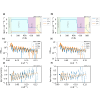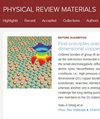低温下 Y3Fe5O12/Bi2Te3 界面的内在磁化动力学探测
IF 3.4
3区 材料科学
Q2 MATERIALS SCIENCE, MULTIDISCIPLINARY
引用次数: 0
摘要
拓扑绝缘体-磁性绝缘体(TI-MI)异质结构在自旋电子学领域大有可为,它为通过拓扑表面态支持的自旋轨道力矩操纵磁化提供了潜力。然而,许多 TI-MI 界面都存在磁绝缘体层污染和拓扑绝缘体低密度过渡区等问题。这些界面难题往往会掩盖 TI-MI 系统的内在行为。在本研究中,我们通过在液相外延生长的 Y3Fe5O12/Gd3Ga5O12 上沉积溅射 Bi2Te3 来解决这些难题。液相外延生长的 Y3Fe5O12 此前已被证明具有优异的界面质量,没有因衬底或杂质离子的相互扩散过程而产生的扩展瞬态层,从而消除了低温下 MI 中与稀土杂质相关的损耗。在 TI-MI 界面上,高分辨率深度敏感偏振中子反射仪证实 TI 不存在低密度过渡生长区。通过克服这些不良的界面效应,我们分离并探测了 TI-MI 界面的内在低温磁化动力学和传输特性。我们的研究结果表明,低温下的自旋泵很强,并伴有额外的面内各向异性。低温下增强的自旋泵与在 TI 薄膜中观察到的体传导抑制和微弱的反聚焦相关,突出了 TI-MI 系统中传输和自旋泵行为之间的相互作用。本文章由计算机程序翻译,如有差异,请以英文原文为准。

Probing intrinsic magnetization dynamics of the Y3Fe5O12/Bi2Te3 interface at low temperature
Topological insulator–magnetic insulator (TI–MI) heterostructures hold significant promise in the field of spintronics, offering the potential for manipulating magnetization through topological surface state–enabled spin-orbit torque. However, many TI–MI interfaces are plagued by issues such as contamination within the magnetic insulator layer and the presence of a low-density transitional region of the topological insulator. These interfacial challenges often obscure the intrinsic behavior of the TI–MI system. In this study, we addressed these challenges by depositing sputtered on liquid phase epitaxy grown . The liquid phase epitaxy grown has been previously shown to have exceptional interface quality, without an extended transient layer derived from interdiffusion processes of the substrate or impurity ions, thereby eliminating rare-earth impurity-related losses in the MI at low temperatures. At the TI–MI interface, high-resolution depth-sensitive polarized neutron reflectometry confirmed the absence of a low-density transitional growth region of the TI. By overcoming these undesirable interfacial effects, we isolate and probe the intrinsic low-temperature magnetization dynamics and transport properties of the TI–MI interface. Our findings revealed strong spin pumping at low temperatures, accompanied by an additional in-plane anisotropy. The enhanced spin pumping at low temperatures is correlated with the observed suppression of bulk conduction and the weak antilocalization in the TI film, highlighting the interplay between the transport and spin pumping behavior in the TI–MI system.
求助全文
通过发布文献求助,成功后即可免费获取论文全文。
去求助
来源期刊

Physical Review Materials
Physics and Astronomy-Physics and Astronomy (miscellaneous)
CiteScore
5.80
自引率
5.90%
发文量
611
期刊介绍:
Physical Review Materials is a new broad-scope international journal for the multidisciplinary community engaged in research on materials. It is intended to fill a gap in the family of existing Physical Review journals that publish materials research. This field has grown rapidly in recent years and is increasingly being carried out in a way that transcends conventional subject boundaries. The journal was created to provide a common publication and reference source to the expanding community of physicists, materials scientists, chemists, engineers, and researchers in related disciplines that carry out high-quality original research in materials. It will share the same commitment to the high quality expected of all APS publications.
 求助内容:
求助内容: 应助结果提醒方式:
应助结果提醒方式:


